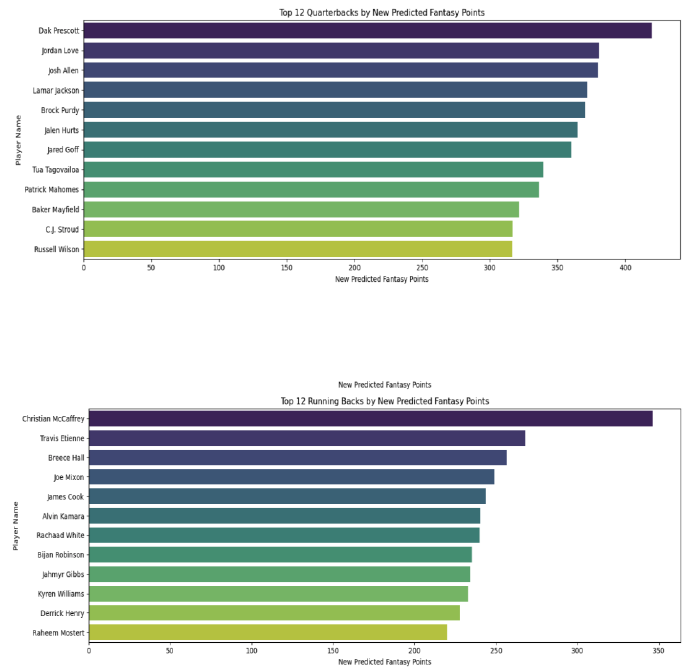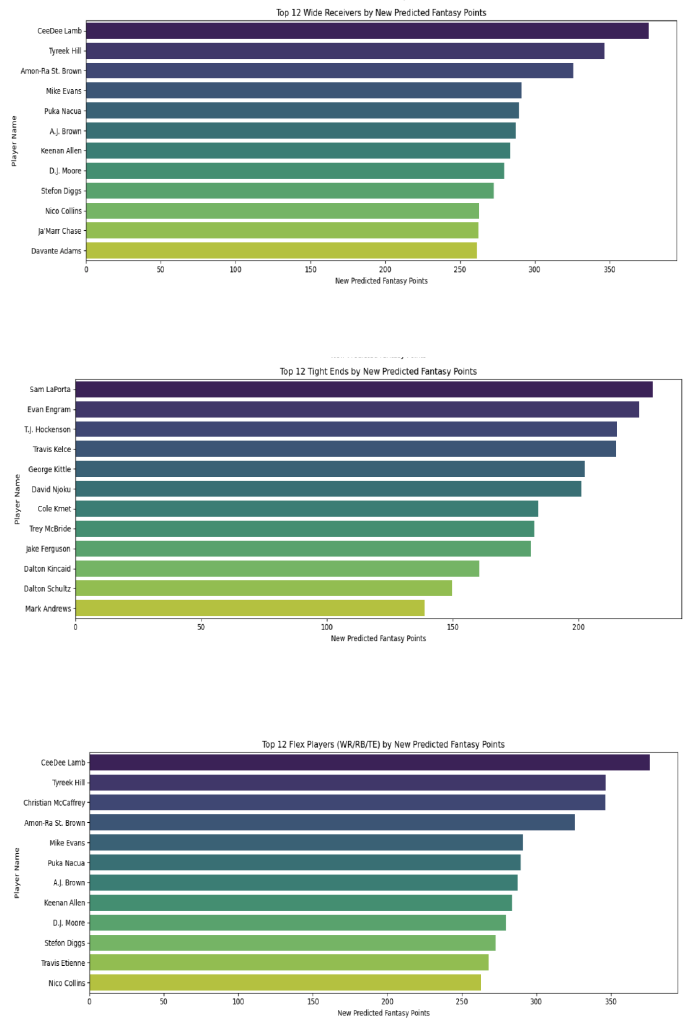
SMU Data Science Review SMU Data Science Review
Volume 8
Number 2
Summer 2024
Article 7
2024
Data Analysis on Predicting the Top 12 Fantasy Football Players Data Analysis on Predicting the Top 12 Fantasy Football Players
by Position by Position
Alan Abadzic
Jacquelyn Cheun
Milan Patel
Southern Methodist University
Follow this and additional works at: https://scholar.smu.edu/datasciencereview
Part of the Data Science Commons
Recommended Citation Recommended Citation
Abadzic, Alan; Cheun, Jacquelyn; and Patel, Milan (2024) "Data Analysis on Predicting the Top 12 Fantasy
Football Players by Position,"
SMU Data Science Review
: Vol. 8: No. 2, Article 7.
Available at: https://scholar.smu.edu/datasciencereview/vol8/iss2/7
This Article is brought to you for free and open access by SMU Scholar. It has been accepted for inclusion in SMU
Data Science Review by an authorized administrator of SMU Scholar. For more information, please visit
http://digitalrepository.smu.edu.

Data Analysis on Predicting the Top 12 Fantasy Football
Players by Position
Alan Abadzic
1
, Milan Patel
2
, Jacquie Cheun-Jensen
3
1
Master of Science in Data Science, Southern Methodist University,
Dallas, TX 75275 USA
[email protected]u.edu
[email protected]u.edu
Abstract. Fantasy football enthusiasts rely on rankings populated by their
platform of choice to draft winning teams and make strategic roster decisions.
This study presents a comprehensive analysis of player performance data to
forecast the top 12 fantasy points performers per position for the upcoming
season. Leveraging machine learning techniques and historical data, our model
identifies key performance indicators and trends to inform player evaluations.
Insights gleaned from positional trends, breakout candidates, risk assessment,
and matchup analysis offer a competitive edge. By addressing limitations, ethical
considerations, and avenues for future research, this study contributes to the
advancement of fantasy sports analysis and enhances fan engagement with the
NFL and other professional leagues.
1 Introduction
Fantasy football is a game where participants can manage the football lineups
and play one on one. This started roughly 50 years ago using pencil and paper
(Shipman, 2009). The process of fantasy football is to build our team through drafting,
which is where participants select one player at a time until the roster is complete. Our
main goal for this research is to determine the top 12 fantasy football players for each
position for the upcoming season. For each position in fantasy football (Quarterback,
Running Back, Wide Receiver, Tight End, Defense, and Kicker), they comprise a rank
of each player, essentially predicting the total number of points scored by that player
and creating a descending list of the totals. The points are determined by the player’s
real-life performance in the game. So, the player who is projected to score the most
points that season would be the number one ranked player for that position. However,
this ranking never ends up being accurate as at the end of the season we find that the
actual ranking contains players that outperformed their projected totals by Yahoo or
vice versa. Relying on their preseason rankings is not the best idea. It would be best to
find a way to more accurately predict a ranking that can outperform competitors who
are relying on Yahoo’s predictions.
Fantasy football is important to investigate because there is real money on the
line and it has become important to fans. It has gained revenue of billions of dollars in
the past years (Becker & Sun, 2016). At the end of the day, fantasy football is mostly
1
Abadzic et al.: Predicting the Top 12 Fantasy Football Players by Position
Published by SMU Scholar, 2024
played to win money. Fantasy football can be played by everyone including individuals
and companies. It can also have its own set of rules for points. There are huge fantasy
football leagues that participants have played in such as Yahoo, Inc. and ESPN, Inc. If
a person can give themselves a competitive edge over the competition, this would allow
them to leverage this advantage to win more money. Fantasy football is easily
manageable due to the lineup being changed weekly within a 17-game season for each
team as well as most games being played on the same day. Rankings are created by
fantasy experts based on historical data and statistics. These rankings are refined
through a combination of domain knowledge and analytical methods.
For this research, there are two ideas that can be used to predict the players
rankings. One of the ideas is to determine the features of importance. Using both
domain knowledge as well as feature selection methods, there will need to uncover
what important statistics play into a player’s future success. This will also include
information about health as well as pure football statistics. There are many factors that
play into a player’s performance such as their coaching staff, training staff, salary, and
overall team. The other idea is to figure out a way to understand and interpret college
player’s statistics so that it can be used to assess their future success in the NFL.
The goal of this research is to use both domain knowledge, as well as feature
selection methodologies to determine what statistics, both football and health, will give
the best picture of a player’s future success. A methodology will be established to
predict the performance of each player based on various metrics for the upcoming
season, which spans 17 games. These predictions will then be used to determine the top
12 fantasy football players in the 2024 season per position. Participants can then decide
in what order they will draft their players in fantasy football based on rankings derived
by our methodology.
2 Literature Review
2.1 Types of Fantasy Football Leagues
There are various types of fantasy football leagues such as draft, draft only,
best ball, custom scoring, dynasty/keeper, guillotine, auction league, and superflex
league (Smola, 2024). The most common type of league is draft league. This league is
where participants create their new lineup (waiver wire and trades included) by drafting
on a yearly basis to compete against their friends, company, etc (Smola, 2024). Drafting
works on a random turn-based system where a participant can have first pick, second
pick, etc. In round 2, the turns are opposite of round 1 where for example, the participant
with the first pick will pick last. Round 3 repeats what was initially done in round 1.
Another type of league is the draft only league which is similar to the regular draft
league except there are no weekly roster moves, management, and trading involved
(Smola, 2024). Participants have to solely rely on their draft picks. The best ball league
is where winning participants are determined by the highest scoring players in the
lineup, whether the players are on the fantasy team’s starting lineup or on the bench
(Smola, 2024). The custom scoring league is where the fantasy football league owner
can set their own scoring rules for each position (Smola, 2024). For example, a
2
SMU Data Science Review, Vol. 8 [2024], No. 2, Art. 7
https://scholar.smu.edu/datasciencereview/vol8/iss2/7
quarterback throwing a touchdown pass can be set to be worth 6 points rather than 4
points. For the dynasty league, participating players retain their current roster for
however many years the owner of the league sets (Smola, 2024). The Keeper league is
very similar to the dynasty league except the participating players can retain a certain
number of players from the previous season based on the set rules (Smola, 2024). The
down side of the keeper league is that participants will be losing a draft pick to retain a
player of their choosing. An emerging type of league is guillotine league. In this league,
the participant with the overall lowest score is eliminated each week until there is only
one fantasy player remaining (Smola, 2024). The eliminated participant’s fantasy
players would be placed back into the waiver pool for the remaining participants to pick
from. The draft league is one way to create a team, but the auction league is completely
opposite where participants will have to bid fictional dollars on players (Smola, 2024).
Similar to real auctions, the highest bidder wins the player. Finally for the superflex
league, there is a position in the fantasy lineup called “flex player” where participants
can choose an extra running back, wide receiver, or tight end (Smola, 2024).
In the dynamic world of fantasy football, the scoring rule set serves as the
guiding framework that transforms on-field actions into tangible fantasy points. Our
scoring system is meticulously crafted to encapsulate the nuances of player
performance across various positions, providing fantasy football enthusiasts with a
comprehensive and engaging gameplay experience.
At the heart of our scoring rule set lies the composition of each team's starting
lineup, carefully structured to encompass a diverse array of offensive and defensive
talent. Quarterbacks (QB), the architects of on-field strategy, earn significant points for
touchdown passes, with each successful throw garnering 6 points. Additionally,
quarterbacks accrue 1 point for every 25 passing yards, while interceptions and fumbles
result in a deduction of 2 points each. Notably, quarterbacks also receive 1 point for
every 10 rushing yards gained, adding a dynamic dimension to their scoring potential.
Running backs (RB), wide receivers (WR), and tight ends (TE) collectively
form the backbone of offensive production in fantasy football. These versatile players
earn 6 points for every touchdown scored, whether through rushing or receiving.
Moreover, the yardage gained by these players is duly rewarded, with 1 point awarded
for every 10 rushing or receiving yards. Notably, catches by wide receivers and tight
ends are valued at 1 point each, underscoring the importance of receptions in fantasy
football scoring.
The flex position offers strategic flexibility to team managers, allowing them
to deploy an additional running back, wide receiver, or tight end based on matchup
advantages and roster depth. Points accrued by players in the flex position are
calculated based on their respective scoring metrics, ensuring equitable scoring
opportunities across all eligible positions.
In addition to offensive players, our scoring rule set also encompasses team
defenses and kickers. Defenses earn points for defensive touchdowns, sacks, and
interceptions, while kickers are rewarded for successful field goals and extra points
converted.
In conclusion, our scoring rule set for fantasy football is designed to mirror
the excitement and unpredictability of real-life NFL action. By meticulously defining
the point allocation for each position and incorporating nuanced scoring metrics, we
aim to provide fantasy football enthusiasts with an immersive and rewarding
3
Abadzic et al.: Predicting the Top 12 Fantasy Football Players by Position
Published by SMU Scholar, 2024
experience, fostering strategic decision-making and competitive gameplay.
2.2 NFL Data Science
The NFL players statistics are collected based on position and how the players
perform against other teams, whether they are offensive players, defensive players, or
special teams players on a weekly and yearly basis. Quarterback statistics are collected
based on pass attempts, pass completion, yards (air or rushing), touchdowns (passing
or rushing), interceptions, and fumbles (total amount and amount lost). Running back
statistics are collected based on rushing attempts, yards (rushing or receiving),
touchdowns (rushing or receiving), and fumbles. Wide receiver and tight end statistics
are collected based on catches, yards, touchdowns, and fumbles. Whereas defense
statistics are collected by team and individual players, fantasy football is collected only
by team. In fantasy football, this statistic consists of yards allowed, touchdowns
(allowed and returned), sacks, punt returns, kickoff returns, punt blocks, field goal
blocks, and turnovers. Kicker statistics are collected based on field goals made, field
goal attempts, yard ranges kicked, and blocked field goals.
NFL statistics are very important because it determines the outcome of a
player and team performance. There are many factors that come into performances such
as the team’s coaches, training staff, and injuries. NFL statistics can outline a player or
team strengths and weaknesses (Khanacademy, n.d.). For example, a team’s defense
can be ranked 32nd for allowing the most amount of yards per game. It allows teams to
have a comprehensive view of their opponents.
2.3 Feature Selection
In constructing our predictive models, we underwent a thorough process of
feature selection to encapsulate the intricate dynamics of player performance in fantasy
football. Drawing from a rich dataset comprising fifty distinct statistics for each player,
our models embraced an extensive array of season-to-date features. The term "season-
to-date" signifies the computation of a rolling average for each statistic up to, but
excluding, the current week's game. This methodology facilitated the incorporation of
past performance metrics as predictors of future player performance. Noteworthy
statistics integrated into the model encompass passing yards, passing touchdowns,
interceptions thrown, rushing yards, receptions, and fumbles lost. (Porter, Predictive
Analytics for Fantasy Football: Predicting Player Performance Across the NFL 2018)
In tandem with season-to-date features, we incorporated game-specific characteristics
to augment predictive accuracy. Binary indicator variables were devised to capture
pivotal attributes of each game, including whether the player competed at home or
away. We recognized the potential influence of home-field advantage on player
performance, thus deeming it essential for inclusion in our models. (Porter, Predictive
Analytics for Fantasy Football: Predicting Player Performance Across the NFL 2018)
Moreover, dummy variables were formulated to account for the offensive inclination
of the player's team, acknowledging that team strategies and dynamics can significantly
impact individual player performance. Lastly, dummy variables for the player's
opponent were integrated into the model, reflecting the caliber of the opposing team,
which in turn can influence player scoring potential. (Baak, Fantasy Football
4
SMU Data Science Review, Vol. 8 [2024], No. 2, Art. 7
https://scholar.smu.edu/datasciencereview/vol8/iss2/7
Profitability: Using Machine Learning to Construct Optimal Teams and See Consistent
Returns 2021)
Through meticulous feature selection, our objective was to fashion models that
adeptly capture the multifaceted nature of fantasy football performance, encompassing
both player-specific metrics and contextual game characteristics. By amalgamating a
diverse range of predictors, our models strive to furnish robust and actionable insights
for fantasy football aficionados, facilitating informed decision-making in draft
selections and lineup management. (Lutz, Fantasy Football Prediction 2015)
2.4 Applying Football Analysis to Fantasy Football
Fantasy football analytics is a burgeoning field that integrates various
methodologies to predict player performance and guide strategic decision-making
within the realm of fantasy sports. This review synthesizes key studies from diverse
perspectives to offer a comprehensive understanding of the methodologies and insights
shaping fantasy football analytics.
David et al. (2011) conducted a seminal study exploring the application of
committees of artificial neural networks to predict NFL outcomes. By leveraging
ensemble methods, the researchers demonstrated notable improvements in prediction
accuracy, highlighting the efficacy of sophisticated modeling techniques in fantasy
football analysis. Their findings underscore the importance of employing advanced
computational methods to enhance predictive capabilities in fantasy football analytics.
Shipman (2009) delved into the theoretical underpinnings of fantasy sports,
presenting the model of blending real and virtual elements in gaming experiences. This
theoretical framework elucidates the psychological and engagement mechanisms
driving fantasy football participation, offering valuable insights into the motivations
and behaviors of fantasy sports enthusiasts. Shipman's work enriches our understanding
of the complex interplay between real-world sports events and virtual gaming
experiences in fantasy football.
Stathole (2020) delved into the relationship between NFL draft selection and
fantasy rookie success. Through empirical analysis of draft data and rookie
performance metrics, Stathole uncovered patterns that shed light on the predictive
power of draft outcomes in fantasy football contexts. This study offers valuable insights
into the role of draft strategies and player evaluations in shaping fantasy football rosters,
providing actionable information for fantasy football enthusiasts seeking to maximize
their team's success.
Shih (2019a) provided practical insights into fantasy football analytics using
machine learning techniques. Through a Medium article, Shih demonstrated the
application of machine learning algorithms to analyze player data and predict fantasy
football outcomes. By leveraging advanced computational methods, Shih's work offers
valuable resources for enthusiasts interested in harnessing data-driven approaches to
enhance their strategic decision-making processes in fantasy football leagues.
5
Abadzic et al.: Predicting the Top 12 Fantasy Football Players by Position
Published by SMU Scholar, 2024
Jdashbrock (2023) provided an introductory overview of time series analysis
in sports, offering insights into the application of temporal data analysis techniques in
understanding sports dynamics. This resource contributes to the growing body of
literature on data-driven approaches in sports analytics, laying the groundwork for
further exploration of time series methodologies in the context of fantasy football
analytics.
In addition to empirical studies and practical applications, the GitHub project
"Predicting fantasy football points using machine learning" (n.d.) offers a hands-on
approach to predictive modeling in fantasy football. This project enables enthusiasts to
experiment with machine learning algorithms and player data by providing access to
code and datasets, fostering a deeper understanding of data-driven approaches in
fantasy football analytics.
These studies contribute to a nuanced understanding of fantasy football
analytics, encompassing theoretical frameworks, empirical investigations, and practical
applications of advanced methodologies. By synthesizing insights from diverse
sources, fantasy football enthusiasts can leverage various tools and perspectives to
enhance their strategic decision-making processes and maximize success in the
dynamic realm of fantasy sports.
By applying advanced statistical analysis methodologies, we will achieve
superior accuracy in predicting the rankings of the top 12 players by position for the
upcoming NFL season compared to Yahoo's predictions.
3 Methods
3.1 Data
Data for this study were obtained from the Pro Football Reference website
spanning the years 2009 to 2023. We focused on player statistics for quarterbacks,
running backs, wide receivers, tight ends, kickers, and team defenses. The final dataset
comprised projected fantasy player data for the top 12 players at each position,
excluding team defenses.
We curated the data to ensure accuracy and consistency across all player
positions. Specifically, we extracted key performance metrics such as passing yards,
touchdowns, rushing yards, receptions, field goal success rates, and defensive statistics.
By encompassing a comprehensive range of player positions, we aimed to capture the
diverse dynamics of fantasy football scoring systems and player contributions.
3.2 Model Architecture
Our project comprises two main components aimed at providing accurate
projections and rankings for fantasy football enthusiasts. In the estimation piece, we
focus on predicting each player's projected points for the upcoming season. To ensure
precision and reliability, we curated a comprehensive dataset encompassing key
performance metrics for players across all positions. This dataset includes crucial
6
SMU Data Science Review, Vol. 8 [2024], No. 2, Art. 7
https://scholar.smu.edu/datasciencereview/vol8/iss2/7
statistics such as passing yards, touchdowns, rushing yards, receptions, field goal
success rates, and defensive contributions.
In our analysis, we leveraged a diverse ensemble of machine learning
algorithms tailored to the unique characteristics of different player positions.
Specifically, we utilized five distinct algorithms: ridge regression, Bayesian ridge
regression, elastic net regularization, random forest, and gradient boosting. Each
algorithm was intricately calibrated to account for the nuances and dynamics specific
to quarterbacks, running backs, wide receivers, tight ends, and place kickers.
To train and assess the performance of our models, we employed rigorous
cross-validation techniques, partitioning the dataset into randomly selected training sets
(80%) and test sets (20%). This approach ensured the robustness and generalizability
of our models by evaluating their predictive accuracy on unseen data. The primary
evaluation metric used to gauge the effectiveness of our models was the root mean
squared error (RMSE), providing a comprehensive measure of accuracy and predictive
precision.
Ultimately, our models were deployed to generate raw projections for the top
12 fantasy players at each position. These projections serve as valuable insights for
fantasy football enthusiasts, empowering them with reliable estimates for player
performance in the upcoming season.
Following the estimation piece, we transition to the ranking component, where
we deploy advanced data science methods to refine and prioritize player projections.
This stage involves accounting for various tangible and intangible factors to determine
the final rankings of players.
By integrating additional data sources and applying sophisticated analytical
techniques, we aim to augment the raw projections generated in the estimation piece.
Factors such as player injury history, team dynamics, schedule strength, and potential
breakout performances are meticulously considered to refine the initial projections.
Through this iterative process, we derive a comprehensive ranking system that
goes beyond mere statistical projections. Our data-driven approach allows us to capture
the holistic impact of players on fantasy football outcomes, providing users with
nuanced insights for draft selections and lineup management.
4 Results
The objective of this research was to identify key features that can be used to
accurately predict the fantasy points of NFL players for the upcoming season, with the
goal of outperforming Yahoo’s Fantasy experts' projections. Through this research, we
aimed to accept or reject the hypothesis that integrating advanced statistical indicators
and machine learning models can significantly improve the accuracy of fantasy football
player performance predictions.
While we cannot definitively confirm our hypothesis until the season
concludes, our preliminary analysis indicates that integrating advanced features with
traditional fantasy point predictions shows potential for enhancing the accuracy of
player rankings. Our model, particularly the Random Forest Regressor, demonstrated
robust and reliable predictions in preliminary tests. This model resulted in a more
nuanced ranking system when combined with additional weighted features. Integrating
features such as offensive contributions, playoff performance, touchdowns, strength of
7
Abadzic et al.: Predicting the Top 12 Fantasy Football Players by Position
Published by SMU Scholar, 2024

schedule, and playing conditions provided a comprehensive view of each player's
potential fantasy value.
Risk factors such as injuries, age, and workload significantly impact player
performance. These factors should be carefully considered when making predictions.
Additionally, it is crucial to ensure the model remains adaptable to team dynamics and
game strategy changes to maintain prediction accuracy.
Beyond the upcoming season, factors contributing to the long-term fantasy
value of players include their durability, role stability, and growth potential. Dynasty
league managers can evaluate player longevity and sustainability by considering these
factors in their strategies.
Team dynamics, such as offensive schemes, quarterback play, and offensive
line performance, significantly influence the fantasy production of individual players.
Analyzing these dynamics, along with matchup factors like opposing defenses and
game scripts, can provide a more comprehensive view of player performance and
enhance predictive models.
4.1 Model Selection and Evaluation
To predict the fantasy points, we experimented with several machine learning
models: Ridge Regression, Lasso Regression, Random Forest Regressor, and Gradient
Boosting Regressor. Each model was evaluated based on its mean squared error (MSE)
and R-squared (R2) values.
After evaluating the performance of each model, the Random Forest Regressor
with hyper-tuned parameters was selected as the final model due to its balance of
accuracy and robustness.
Table 1. This table shows the comparison of the performances for each of the different
models.
Model
Mean Squared Error
R-Squared
Ridge Regression
2.54
0.9997
Lasso Regression
2.51
0.9997
Random Forest Regressor
53.85
0.9936
Gradient Boosting
Regressor
42.71
0.9949
4.2 Integration of New Features and Final Predictions
We then integrated the projected fantasy points from the Random Forest
model with additional weighted features to derive new predictions. This weighted
approach allowed us to refine the player rankings by considering both the projected
8
SMU Data Science Review, Vol. 8 [2024], No. 2, Art. 7
https://scholar.smu.edu/datasciencereview/vol8/iss2/7

points and additional influential factors.
4.3 Rankings per Position
Fig 1. This shows a figure consisting of the top 12 quarterbacks by the new predicted fantasy
points. The darker the color, the higher the ranking based on the projected fantasy points.
Fig 2. This figure consists of the top 12 running backs based on the newly predicted fantasy
points. The darker the color, the higher the ranking based on the projected fantasy points.
9
Abadzic et al.: Predicting the Top 12 Fantasy Football Players by Position
Published by SMU Scholar, 2024

Fig 3. This shows a figure consisting of the top 12 wide receivers by the new predicted fantasy
points. The darker the color, the higher the ranking based on the projected fantasy points.
Fig 4. This shows a figure consisting of the top 12 tight ends by the new predicted fantasy
points. The darker the color, the higher the ranking based on the projected fantasy points.
Fig 5. This shows a figure consisting of the top 12 flex (wide receiver, running back, and tight end) players by the
new predicted fantasy points. The darker the color, the higher the ranking based on the projected fantasy points.
10
SMU Data Science Review, Vol. 8 [2024], No. 2, Art. 7
https://scholar.smu.edu/datasciencereview/vol8/iss2/7
5 Discussion
5.1 Interpretation of Results
Based on the results, the best draft team is Dak Prescott at quarterback,
Christian McCaffrey at running back, CeeDee Lamb and Tyreek Hill at wide receiver
or flex, and Sam LaPorta at tight end.
5.2 Implications
These findings are significant for fantasy football enthusiasts and analysts.
Users can make more informed decisions when drafting and managing their fantasy
football teams by employing a multifaceted approach that considers both projected
points and contextual factors. This approach not only improves the accuracy of player
evaluations but also enhances strategic planning for both drafts and in-season
management.
5.3 Limitations
The primary limitation of this research is the inherent variability and
unpredictability of sports performance. Player injuries, sudden changes in team
dynamics, and unanticipated external factors can significantly impact performance and
are challenging to predict accurately. Another challenge encountered was ensuring the
model's adaptability to these dynamic conditions. Although historical data provides a
strong foundation, it may not fully capture the complexities of future performances.
Additionally, the effectiveness of the model in real-world applications remains to be
validated at the end of the season when actual player performances can be compared to
the predictions.
5.4 Ethics
The ethical considerations in this research primarily involve the accuracy and
fairness of the predictions. Ensuring that the models do not disproportionately favor
certain players or teams over others is crucial. Additionally, transparency in how
predictions are made is important for maintaining trust among users.
5.5 Future Research
Future work could involve integrating real-time data and improving models
through advanced techniques like deep learning and reinforcement learning. Future
research could delve deeper into other influential factors such as injury histories, age,
workload, and other risk factors that impact the reliability and consistency of player
performance. Additionally, exploring long-term player value and how it affects dynasty
league management could provide further insights. Analyzing team dynamics and
matchup factors could also enhance the predictive model's accuracy.
11
Abadzic et al.: Predicting the Top 12 Fantasy Football Players by Position
Published by SMU Scholar, 2024

6 Conclusion
The research suggests that integrating advanced features with machine
learning models has the potential to enhance the accuracy of fantasy football player
performance predictions. By employing a Random Forest model and incorporating
additional weighted features, we developed a comprehensive and nuanced ranking
system that shows promise as an accurate ranking methodology. These preliminary
findings offer valuable insights for fantasy football enthusiasts and analysts, enabling
more informed decision-making and strategic planning. While using historical data,
factors such as age, injury history, and team dynamics appear to play crucial roles in
predicting player performance. Future evaluations will determine the model's
effectiveness compared to traditional methods, providing a solid foundation for more
sophisticated fantasy football prediction models.
References
1. Jdashbrock. (2023, June 26). Intro to time series and sports. The Data Jocks.
https://thedatajocks.com/time-series-sports-
101/#Time_Series_Examples_in_Sports.
2. Shih, H. (2019a, October 2). Fantasy Football Analytics using machine
learning. Medium. https://medium.com/swlh/fantasy-football-analytics-
using-machine-learning-757d21989418
3. Meil, A. J. (2018). Predicting success using the NFL Scouting ...
PREDICTING SUCCESS USING THE NFL SCOUTING COMBINE.
https://scholarworks.calstate.edu/downloads/1z40kt64t
4. Predicting fantasy football points using machine learning. GitHub. (n.d.).
https://github.com/zzhangusf/Predicting-Fantasy-Football-Points-Using-
Machine-Learning/blob/master/README.md
5. Stathole, J. (2020, May 15). How NFL draft selection predicts fantasy rookie
success. Dynasty Nerds. https://www.dynastynerds.com/how-nfl-draft-
selection-predicts-fantasy-rookie-success
6. Becker, A. & Sun, X. (2016). An analytical approach for fantasy football draft
and lineup management. Journal of Quantitative Analysis in Sports, 12(1), 17-
30. https://doi.org/10.1515/jqas-2013-0009
7. Shipman, F. M. (2009). Blending the real and virtual in games: The model of
fantasy sports. Proceedings of the 4th International Conference on
Foundations of Digital Games, 169–174.
12
SMU Data Science Review, Vol. 8 [2024], No. 2, Art. 7
https://scholar.smu.edu/datasciencereview/vol8/iss2/7

https://doi.org/10.1145/1536513.1536547
8. Dunnington, N. (2015). Fantasy Football Projection Analysis.
https://cassites.uoregon.edu/econ/wp-
content/uploads/sites/4/2015/03/Dunnington_Thesis_2015.pdf
9. Purdum, D., & Rovell, D. (2015, November 12). N.Y. AG declares DraftKings,
FanDuel are illegal gambling, not fantasy. ABC News.
https://abcnews.go.com/Sports/ny-ag-declares-draftkings-fanduel-illegal-
gambling-fantasy/story?id=35169500
10. Becker, A., & Sun, X. A. (2016). An analytical approach for fantasy football
draft and lineup management. Journal of Quantitative Analysis in Sports,
12(1). https://doi.org/10.1515/jqas-2013-0009
11. Smola, J. (2024, Apr 11). Types of Fantasy Football Leagues. DraftSharks.
https://www.draftsharks.com/kb/types-of-fantasy-football-leagues
12. Khan Academy. (n.d.). Statistics in Football.
https://www.khanacademy.org/partner-content/49ers-steam/49ers-geometry-
statistics/49ers-statistics/a/statistics-in-
football#:~:text=Statistics%20can%20influence%20what%20players,Footbal
l%20League%20(NFL)%20Draft
13. Lutz, R. (2015). Fantasy Football Prediction.
https://arxiv.org/pdf/1505.06918.pdf
14. Porter, J. W. (2018). Predictive Analytics for Fantasy Football: Predicting
Player Performance Across the NFL.
https://scholars.unh.edu/cgi/viewcontent.cgi?article=1418&context=honors
15. Baak, A. (2021). Fantasy Football Profitability: Using Machine Learning to
Construct Optimal Teams and See Consistent Returns.
https://honors.libraries.psu.edu/files/final_submissions/7309
13
Abadzic et al.: Predicting the Top 12 Fantasy Football Players by Position
Published by SMU Scholar, 2024
